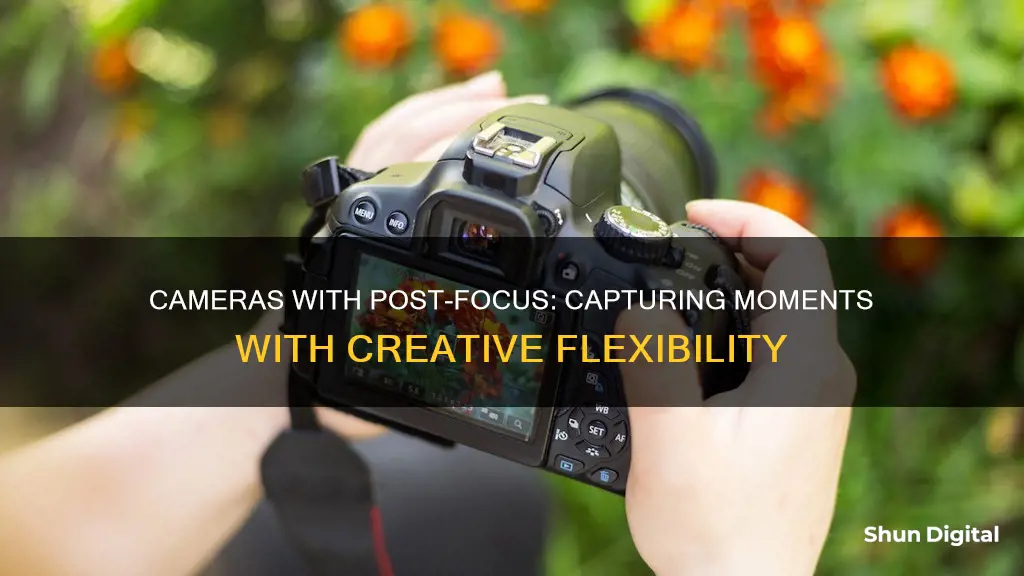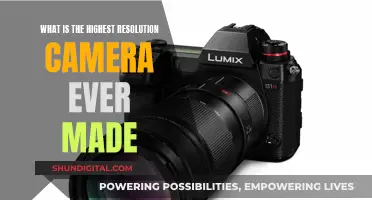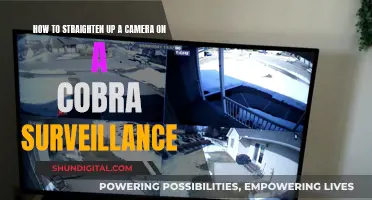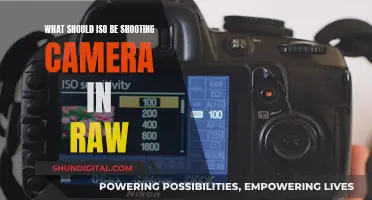
Panasonic has introduced a new feature called 'Post Focus' to some of its cameras that run 4K video on a Micro Four Thirds sensor. This feature allows the user to select a point of focus after a shot is taken and to select different points of focus within the same image. Post Focus works by taking burst shots in 4K resolution at 30fps across up to 49 areas within the frame, giving the user 49 different focus points to choose from. The user can then select which still frame they want from the corresponding plane of focus. Post Focus is currently available on the Panasonic LUMIX DMC-GH4, DMC-GH4R, DMC-G7, DMC-GX8, DMC-FZ330, DMC-TZ80, DMC-TZ100, and DMC-GX80.
| Characteristics | Values |
|---|---|
| Camera Model | Lumix DMC-GX8, DMC-G7, DMC-FZ300, DMC-GH4, DMC-GH4R, DMC-GX80, DMC-TZ80, DMC-TZ100 |
| Resolution | 3840 x 2160 pixels |
| Frames per second | 30 |
| Focus Points | 49 |
| Firmware | 2.0 |
What You'll Learn
- Panasonic's Post Focus feature is available on the Lumix DMC-GX8, G7, FZ300, GH4, GH4R, FZ2500, LX10, and G85
- Post Focus utilises Panasonic's 4K technology, capturing burst shots at 30fps with up to 49 focus points
- Post Focus is a focus bracketing function that allows you to choose your preferred focus point after the image has been taken
- Post Focus is ideal for macro photography, where precision focusing is crucial
- Post Focus can be used to achieve creative variations in depth of field in landscape and portrait photography

Panasonic's Post Focus feature is available on the Lumix DMC-GX8, G7, FZ300, GH4, GH4R, FZ2500, LX10, and G85
To use the Post Focus feature, set the camera to Post Focus mode and press the shutter button. The camera will automatically adjust the focus while capturing photos with different focus points. During playback, use the touch screen to select the desired focus area, and save the image as a separate 8-megapixel photo file. The process can be repeated as many times as desired to get multiple images with different focus points.
The Post Focus function is best suited for non-moving subjects, such as portraits or landscapes, and is ideal for shooting at wide apertures to create shallow depth of field effects. It can also assist advanced users in macro photography by allowing them to capture multiple frames with different focus points and then using third-party software to perform focus stacking, creating images with more areas in sharp focus.
The Post Focus feature is enabled through a firmware update for the supported Lumix cameras and can be downloaded from the LUMIX Global Customer Support Site.
How to Insert Batteries into Your FinePix S8200 Camera
You may want to see also

Post Focus utilises Panasonic's 4K technology, capturing burst shots at 30fps with up to 49 focus points
Panasonic's Post Focus feature utilises the company's 4K technology to capture burst shots at 30fps with up to 49 focus points. This feature is available on the Panasonic Lumix DMC-GX8, G7, FZ300, DMC-GH4, DMC-GH4R, DMC-TZ80, DMC-TZ100, and DMC-GX80.
The Post Focus feature is essentially a focus bracketing function that stacks a burst of images together into a single file. The camera uses its 4K video mode to record the bracket, shooting 30 frames in a second, and providing 30 different focus points in just one second of footage. The user can then choose which focus point they prefer after the image has been taken by touching the subject on the camera's rear screen.
The Post Focus function has been made possible by Panasonic's high-speed, high-precision DFD (Depth From Defocus) autofocus technology.
Quickly Copy Adjustments: Camera Raw Secrets
You may want to see also

Post Focus is a focus bracketing function that allows you to choose your preferred focus point after the image has been taken
The Post Focus function works by shooting a burst of images in 4K resolution (3840 x 2160 pixels) at 30 frames per second while detecting up to 49 areas of a frame to set focus at different points, ranging from near to far. This is made possible by Panasonic's high-speed, high-precision DFD (Depth From Defocus) autofocus technology.
The benefit of using the Panasonic system for focus bracketing is that multiple images can be collected in a very short space of time, and a tripod is not needed unless your hands are very unsteady. The images are collected automatically, and all that is required is to review the clip to extract the desired images.
The main downside of the Post Focus function is the time it takes to record the video footage and the brevity of the clip. It is important to keep the camera still during the one-second recording, and it can be challenging to control subject movements. The Post Focus function is best suited for scenes that are primarily static, as panning the camera or having moving subjects can result in the desired focus point never being achieved.
Mobile Autofocus Camera: How Does It Work?
You may want to see also

Post Focus is ideal for macro photography, where precision focusing is crucial
Post Focus is a feature that allows you to select the point of focus after you have taken the image. It is available on some Panasonic Lumix cameras, including the GX8, G7, and FZ300. It is a useful feature for macro photography, where precision focusing is crucial.
Macro photography is a difficult genre, where you are pushing up against the physical limits of depth of field, diffraction, and motion blur. Focusing in macro photography is a crucial and challenging task. The smaller the subject, the more difficult it is to focus. When shooting at a magnification of 1:1 or stronger, the depth of field becomes remarkably small. Even if you want just the head and body of an ant to appear in focus simultaneously, you are probably out of luck.
The Post Focus feature is based on Panasonic's 4K technology. It takes burst images in 4K resolution at 30 frames per second while detecting up to 49 areas of a frame to set focus at different points. This allows you to choose the best shot that meets your photographic intention. You can also adjust the focus point on the touch monitor as you like.
The benefit of using the Panasonic system for macro photography is that multiple images can be collected in a very short space of time, and a tripod is not needed unless your hands are very unsteady. The images are collected automatically, and all that is required is to review the clip to extract the images you want to work with.
However, there are some limitations to the Post Focus feature. The final image will be no more than eight megapixels. Additionally, the process is designed for use with static scenes, and it will not work well with moving subjects or panning the camera during the exposure.
Battery Exhausted: Quick Tips to Revive Your Camera
You may want to see also

Post Focus can be used to achieve creative variations in depth of field in landscape and portrait photography
Post Focus is a feature developed by Panasonic that allows photographers to select the point of focus after the image has been taken. It is a focus bracketing function that stacks a burst of images together into a single file. The photographer can then choose which focus point they prefer by touching the subject on the camera's rear screen. This is particularly useful for landscape and portrait photography, as it allows for creative variations in depth of field.
Depth of field refers to the zone within a photo that appears acceptably sharp and in focus. It is an essential artistic component of each photo and can make a huge difference in how the shot is perceived. There are three main factors that determine the depth of field in a photo: the lens's aperture setting, the distance between the lens and the subject, and the focal length of the lens. By adjusting these variables, photographers can determine the amount of their image that turns out sharp and the amount that is blurry.
A deep depth of field is when the zone of sharpness is very large, and the photo tends to be sharp from the front to the back of the image. This type of depth of field is popular in landscape photography, where the goal is often to show every little detail of the scene. On the other hand, a shallow depth of field is when the zone of sharpness is very small, and the subject is in focus while the background is blurry. This type of depth of field is popular in portrait photography, as it draws attention to the subject and prevents background distractions.
In addition to landscape and portrait photography, Post Focus can also be useful in other genres such as wildlife photography, sports photography, macro photography, street photography, and photojournalism. It gives photographers the flexibility to choose the point of focus after capturing the image, allowing for creative variations in depth of field and enabling them to tell more effective stories through their images.
Choosing the Right Microphone for Selfie-Mode Photography
You may want to see also
Frequently asked questions
Panasonic has released firmware that enables a post-capture 'refocusing' feature in some of its cameras that run 4K video on a Micro Four Thirds sensor. Cameras that have this feature include the Lumix DMC-GX8, DMC-G7, DMC-GH4, DMC-GX85, DMC-FZ300, DMC-FZ330, DMC-TZ80, DMC-TZ100, and DMC-GX80.
Post-focus is a feature that allows you to set the focus of an image after it has been taken. It works by taking burst shots in 4K resolution at 30fps across up to 49 areas within the frame, giving you 49 different focus points to choose from. You can then select which still frame you require from the corresponding plane of focus with one simple touch of the camera’s screen.
Post-focus ensures that your shots are always in focus, so even if you focus incorrectly, you won’t miss out on capturing the moment in perfect detail. It also allows for creative variations in depth of field and is particularly useful for macro photography, where precision focusing is of paramount importance.
To use the Post Focus feature, simply turn on the Post Focus mode on your camera and take your shot as you normally would. Upon reviewing your photo on your camera’s monitor screen, you can touch the area of the image that you want to be in focus, and an additional still will be produced with the post focusing you have selected now applied.







